 I enjoyed the time I taught and mentored mothers and fathers. I was able to share stories, experiences, and resources. I met many parents who wanted to create strong family cultures and tight relationships with their children. The years that I did this work were sincerely fulfilling.
I enjoyed the time I taught and mentored mothers and fathers. I was able to share stories, experiences, and resources. I met many parents who wanted to create strong family cultures and tight relationships with their children. The years that I did this work were sincerely fulfilling.
I recall getting an email from a very harried mom with a three-year-old. I laugh about it still because I can relate!
“YIKES!! My three-year-old wants me to help him with everything!! I need some activities and games for small children!”
Not long after, I got an email from a mom who was homeschooling. She loved working with her eight-year-old, but she had two littles who made it difficult to give her older son the attention she wanted to. She needed some diversions for those little ones. She planned for all of them to be in the same room, but she needed her littles to be able to play happily without her help for short periods.
Small children want their mom or dad to be with them. It’s all about “being present” and frankly, their little hands need more help figuring things out so they can keep going. So, what’s a mother to do when she needs to help an older child or wants to keep a little one entertained while she does dishes, folds laundry, or works from home? And then there are times a mother wants to do some learning or reading of her own. We are so good at multitasking that if we can keep the littles happy at our feet, we can do some of our own work and study.
At that time, I put the question to my readers and was amazed at the wonderful answers they gave. If you have littles and need them to learn or play on their own for bites of time, give some of these ideas a try. Most of them came from moms who have mixed ages in their homes, some school at home, and some work from home. They are tried and true. : )
Activities and Games for Small Children
- Building blocks activity – my kids LOVED magnetic blocks and my grands still do. Any type of blocks will work.
- Lego’s. “Throw a sheet on the floor and dump the whole caboodle in the middle. They can swim in them if they want to so long as they keep them on the sheet. When it’s time to clean up, fold the four corners together and dump the lot back into the container.”
- A marble shoot game…”Use tubes that create a tall tower. They drop the marble at the top and watch it go through the tubes down to the bottom.” (Make sure your child has reached the age where they won’t put the marbles in their mouths. : ) You could have an older child create one for the littles. Here is one created by a mom in minutes. If you don’t mind a bit of noise this is fun. You would have to make it lower on a wall and wouldn’t need as many parts.
- Play-Doh activity – Provide an old rolling pin and have them play on the floor with a variety of cookie cutters.
- Geo-trax. There are so many different versions of this. If you have one, use it.
- Try a shoe box for each day of the week. “In each box, there are a variety of toys to play with that day. When you are done, close the box…next day is a new box with new things to discover. (It could be anything…not just toys, but nesting Tupperware, spoons, rocks…anything new can be exciting.)”
- A pile of stacking cups and a pile of math manipulatives “(1×1 inch tiles in the same colors as the stacking cups) make a great learning activity for young children. This worked for my two-year-old as long as she could sit in the middle of the kitchen table with them. She did it every single day the whole school year pouring, sorting, and making piles of those little tiles.”
- Mr. Potato Head game.
- Lacing cards.
- Large beads to string.
- Painting! “Before you run screaming, let me tell you they can paint quite happily with water. If you give your little ones some colored construction paper, a big paintbrush, and a small cup of water, they can “paint” to their hearts’ content. If they spill anything, it’s just water. Put them on the table with a vinyl cover and put a towel over that.”
- Pegboard and big plastic pegs.
- Buy a package of paper cups and let your children play with them. They can nest them, stack them, build with them, etc. If they get mashed, no loss. In fact, if you’re like me, you might want to take a few at the end of playtime, place them upside down along the floor, and then jump on them. Kids LOVE this. It is the reward for playing quietly for a while, alone.
- Nesting cups.
- An indoor sandbox? “When my children were small, we had one of those turtle sandboxes, with the cover, in the house. We put some plain white rice in it, and some appropriate toys: scoops, shovels, containers, etc. They LOVED it! If you don’t want an entire sandbox, you can fill a smaller container with rice, and let them play in that. Place it on a sheet for easier clean up.”
- “If you have time to make some materials, you can make fun matching games from posters. Dollar stores often have education posters. Buy two posters, cut up one of them, attach Velcro to the back of the pieces, attach the other part of the Velcro to corresponding areas on the intact poster, and voilà! You have a lovely matching activity for them. Do this with colors, shapes, numbers, letters, or anything that lends itself to matching. Hang the posters on the wall. This is a great learning activity for young children.”
- Board books. You can find books that have textures, which are nice for the little ones. You don’t have to buy them new.
- A small folding dryer rack, some washcloths, and a few clothespins.
- A little spray bottle of water, a sponge, and a table they can “clean.”
- Plastic rubbing plates, plain paper, and crayons.
- Plastic food is always a hit, especially if you also have plastic plates upon which to serve it.
- Stuffed animals and some blankets or baby clothes.
- A magnetic dry-erase board and a fun set of magnets.
- “If you have room- a train table with bins underneath is great because they can do so much on top of it, and everything stores beneath it.”
- Audiobooks – When they were small some of my grands loved this activity.
- Simple art supplies: crayons, paper, pencils, clay, etc.
- “Deliberately leave things undone–kids at that age love to help with the right encouragement. Whenever you notice that attention fading, send your little one to go ‘do something’. Leave your shoes in a silly place for example. If approached with the right cheerfulness, a 4-year-old will certainly hunt for 30 min. or more for Mother’s sweater, not just because she’s cold but because it is so funny to discover silly mom left it in the soup pot again!”
- Make a game of chores: “Folding laundry is one–sure you may have to re-fold it, but it does work. Feeding pets, setting the dinner table (does it matter if you won’t eat for a few hours?), cleaning baseboards (because no one really cares what they look like), making lunch or a snack–a 4-year-old is quite a gracious host if given the responsibility. They can do all kinds of things with fruit and veggies and dip and even make sandwiches.”
- “Montessori websites have great suggestions for toys, games, and learning activities for young children. The best book on making your own Montessori materials is Teaching Montessori in the Home: The Pre-School Years by Elizabeth Hainstock.”
- Find a workbook for preschoolers.

- Cutting, pasting, and tracing.
- Mini trampoline.
- Plastic balls in a big pot. You can go cheap and fill up a kiddie pool with them if there is space.
- Make a fort with sheets or blankets.
- You may not believe it, but some little children love to sort socks.
- Big cardboard boxes will keep any young child busy for hours. I used this and they played for hours. They really liked decorating them with crayons.
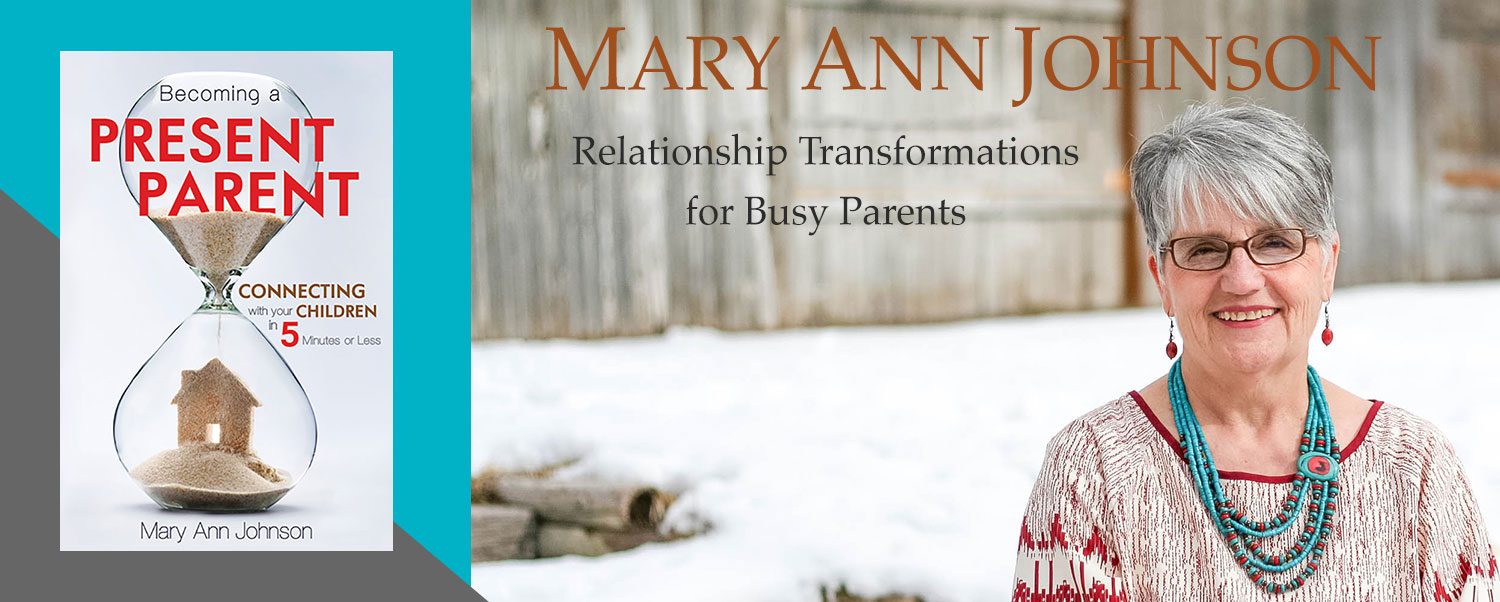

 Back in 2013, when Jodie and her family moved into our three-bedroom apartment while looking for a new home, I was reminded of many things I had forgotten since my children had grown up and moved away. It takes flexibility to manage a family. Things don’t always go the way you plan, and moving forward when things aren’t just what you want, well, that is the road to feeling good as a family. Here is a peek back to that ‘learning’ time. By the way, Jodie was homeschooling Maggie and Jack and bringing Mary on board. It was a big load!
Back in 2013, when Jodie and her family moved into our three-bedroom apartment while looking for a new home, I was reminded of many things I had forgotten since my children had grown up and moved away. It takes flexibility to manage a family. Things don’t always go the way you plan, and moving forward when things aren’t just what you want, well, that is the road to feeling good as a family. Here is a peek back to that ‘learning’ time. By the way, Jodie was homeschooling Maggie and Jack and bringing Mary on board. It was a big load! Family chores are one way that Jodie helps the children gain confidence and pride in their abilities. Jack was supposed to fold clothes. I saw Jodie pull folded dishcloths out of the drawer, unfold them, and give them to Jack to fold. (He didn’t see her unfold them.) This happened because there wasn’t any clean laundry to fold. It wasn’t that there wasn’t any laundry; it was just all still dirty. Often laundry takes a back seat to what really matters. : )
Family chores are one way that Jodie helps the children gain confidence and pride in their abilities. Jack was supposed to fold clothes. I saw Jodie pull folded dishcloths out of the drawer, unfold them, and give them to Jack to fold. (He didn’t see her unfold them.) This happened because there wasn’t any clean laundry to fold. It wasn’t that there wasn’t any laundry; it was just all still dirty. Often laundry takes a back seat to what really matters. : )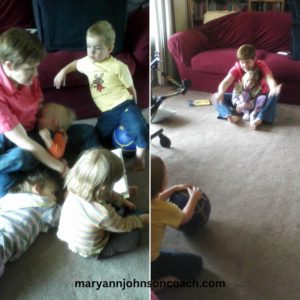 and Andy”. Then they played ball. Maggie needs help with this activity. Jack is a great big brother and did his part. Then we made hedgehogs.
and Andy”. Then they played ball. Maggie needs help with this activity. Jack is a great big brother and did his part. Then we made hedgehogs. I was so busy helping that I didn’t get a photo of the table before the project began. I would have loved for you to see it. It was a disaster. Most of what we used for dinner was still there from the night before. I am sorry to have to confess that, but there it is. Some nights we move on to something else right after the meal and often, well, we are tired. : ) Jodie did what any great mom would do. She pushed it out of the way and carried on.
I was so busy helping that I didn’t get a photo of the table before the project began. I would have loved for you to see it. It was a disaster. Most of what we used for dinner was still there from the night before. I am sorry to have to confess that, but there it is. Some nights we move on to something else right after the meal and often, well, we are tired. : ) Jodie did what any great mom would do. She pushed it out of the way and carried on.


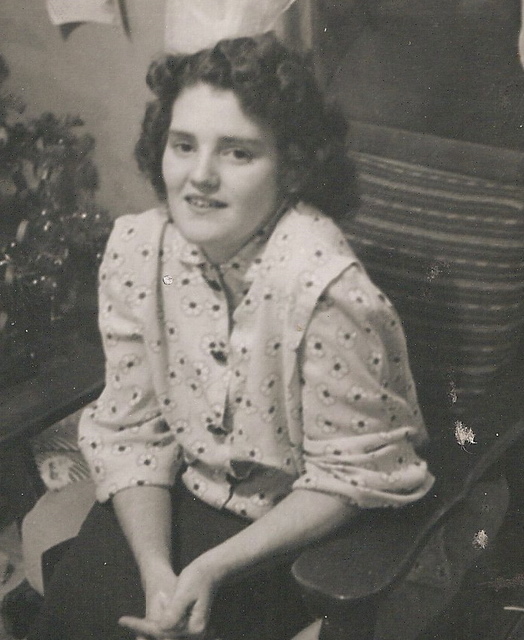







 Keep It Simple
Keep It Simple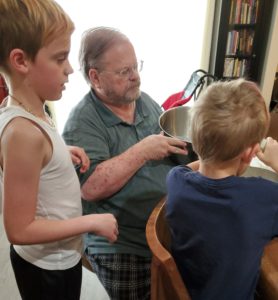 reasoned that he could help the two boys, one 12 and one 6. The 12-year-old wouldn’t need much help. I would help the girls, one 10 and one 14, with special needs. The 10-year-old is creative and fairly independent. That should work out alright.
reasoned that he could help the two boys, one 12 and one 6. The 12-year-old wouldn’t need much help. I would help the girls, one 10 and one 14, with special needs. The 10-year-old is creative and fairly independent. That should work out alright. NOT! Don couldn’t manage two at a time and was totally involved with the six-year-old. That left me with three. As for the twelve-year-old, I discovered that when it comes to cooking, he needed a lot of help. And as far as the 10-year-old goes, she couldn’t read my cursive. Of course, her recipe card was in my cursive. Sigh. It was like trying to wrangle chickens. You’ve never done that. Well, trust me, it’s tiring!! And here is another thing. I am perfectly aware that expectations can do a good project in. I teach that. I am an expert.
NOT! Don couldn’t manage two at a time and was totally involved with the six-year-old. That left me with three. As for the twelve-year-old, I discovered that when it comes to cooking, he needed a lot of help. And as far as the 10-year-old goes, she couldn’t read my cursive. Of course, her recipe card was in my cursive. Sigh. It was like trying to wrangle chickens. You’ve never done that. Well, trust me, it’s tiring!! And here is another thing. I am perfectly aware that expectations can do a good project in. I teach that. I am an expert. cream the sugar and shortening, no problem. Then they will cook their cookies, we will eat some and each will clean up their spot on the table. WHAT WAS I THINKING!!!
cream the sugar and shortening, no problem. Then they will cook their cookies, we will eat some and each will clean up their spot on the table. WHAT WAS I THINKING!!! I have to say, that
I have to say, that 
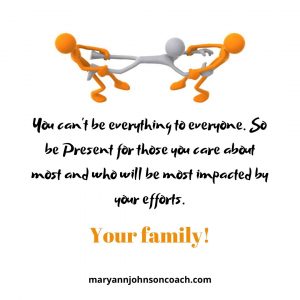 I saw an insurance commercial in which the adults (portrayed by kids) were being treated like children by the insurance company. They felt helpless, undervalued, and frustrated. When I saw this commercial, I, like most of you, could relate to those feelings. At the end of the commercial, a rival insurance company helped a woman (portrayed by a child) with her needs. She stood there smiling, feeling good.
I saw an insurance commercial in which the adults (portrayed by kids) were being treated like children by the insurance company. They felt helpless, undervalued, and frustrated. When I saw this commercial, I, like most of you, could relate to those feelings. At the end of the commercial, a rival insurance company helped a woman (portrayed by a child) with her needs. She stood there smiling, feeling good. of my relaxing and fun things to-do list. I was feeling some pressure. My 3-year-old daughter, Marie, kept coming into the sewing room and interrupting me. This and the sewing were wearing on my nerves. I was ready to spank her. After all, she was bugging me, and she could see perfectly well that I was busy! I decided if she interrupted me again, I was going to swat her.
of my relaxing and fun things to-do list. I was feeling some pressure. My 3-year-old daughter, Marie, kept coming into the sewing room and interrupting me. This and the sewing were wearing on my nerves. I was ready to spank her. After all, she was bugging me, and she could see perfectly well that I was busy! I decided if she interrupted me again, I was going to swat her.
 Kids
Kids 




 We only have one rule during Lego play. After they’re finished all Lego’s are to be put on top of the play table or under it.
We only have one rule during Lego play. After they’re finished all Lego’s are to be put on top of the play table or under it.


 I’m inspired and motivated by my children’s ability to learn and their level of creativity. I could have never imagined, and I can barely even think of what we would be missing out on if I hadn’t gotten over my negative thought patterns of “Lego’s are a mess” and “Lego’s are a waste of time”! Thank you, Mary Ann!
I’m inspired and motivated by my children’s ability to learn and their level of creativity. I could have never imagined, and I can barely even think of what we would be missing out on if I hadn’t gotten over my negative thought patterns of “Lego’s are a mess” and “Lego’s are a waste of time”! Thank you, Mary Ann!


